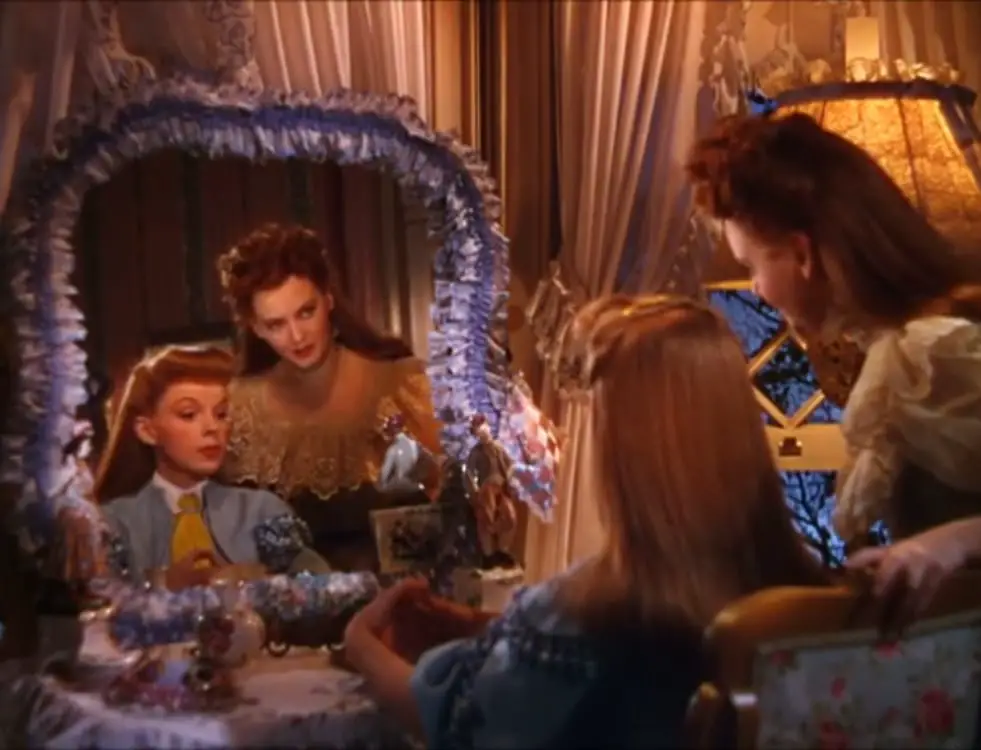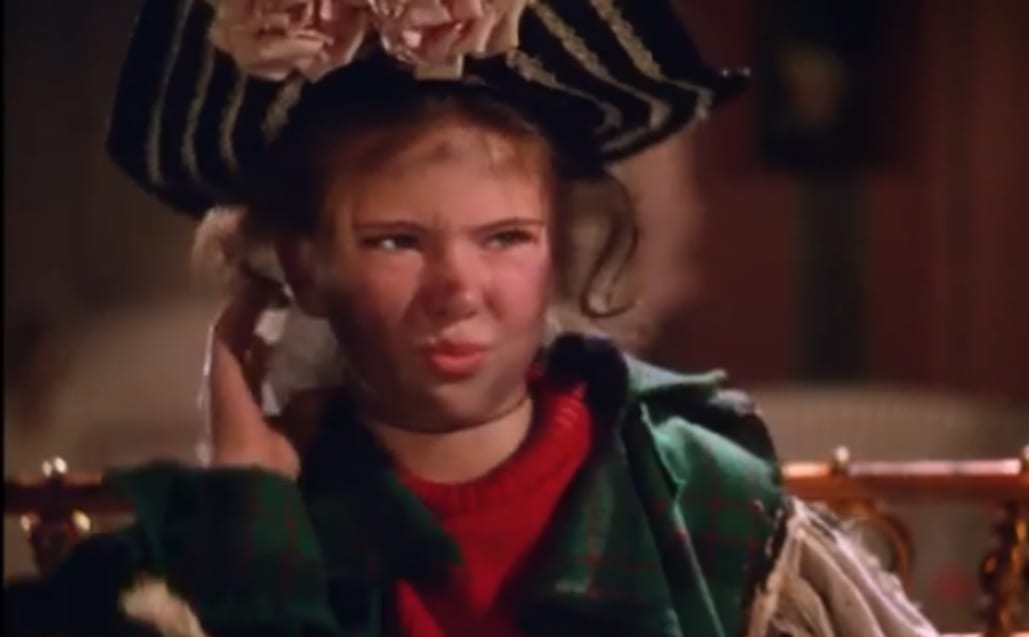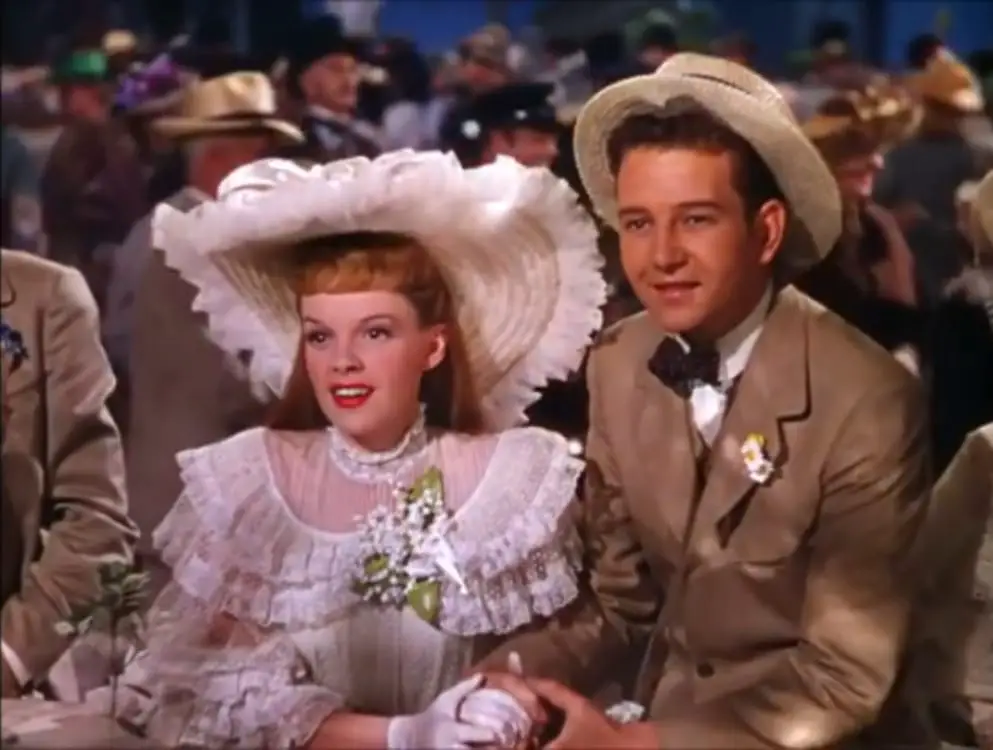Meet Me in St. Louis is many, many things. MGM’s glittering movie musical, directed by Vincente Minnelli, showcasing Judy Garland and Margaret O’Brien and offering such standards as “The Trolley Song” and “Have Yourself a Merry Little Christmas,” is really the epitome of what Hollywood can achieve when it turns a blind eye to historical injustice and wartime sensibility—four Academy Award nominations, a 10th place ranking on AFI’s Greatest Movie Musicals, and a 100% rating on Rotten Tomatoes. While utilizing both the city of St. Louis and the 1904 World’s Fair as only the thinnest of backdrops, the movie explores the ups and downs of the Smith family in the year leading up to the extravaganza, including the elder sisters’ romances, the threat of relocation to New York, and several songs along the way.
From a narrative perspective, we can explore how a film that so flagrantly ignored the realities of its own setting relied on form and function, especially narrative fidelity, to be such a success with moviegoers. It is a wartime-film based off of a series of short stories that recalled “the good old days.” Naturally, the simple realities of daily life in turn-of-the-century midwestern America had no place on the screen.
Meet Me in St. Louis takes place over the year 1903 in St. Louis leading up to the opening of the 1904 World’s Fair. It focuses on the Smith family, particularly the second eldest daughter Esther, played by Judy Garland, and the youngest daughter Tootie, played by Margaret O’Brien. We see Esther scheme with eldest sister Rose to try to get the attention of the boy next door, John Truett, with whom Esther is infatuated, and Tootie scheme with second youngest sister Agnes to commit as many tomboyish scandals as they can.
The film works in tandem with its 1903 setting’s ideals and its 1944 audience’s ideals, especially in terms of gender roles, which, unlike questions of race and class that are entirely unexplored in the film, are given a thin but existent treatment.
We are shown several times that the women of the house, Mrs. Smith and longtime maid Katie, exhibit limited power over breadwinner Mr. Smith. On one occasion, the two conspire to get Mr. Smith away from the dining room before an expected phone call from Rose’s beau. But their plans are thwarted through Mr. Smith’s stubbornness and blustering, his right as man of the house.
Similarly, Esther and Rose’s boy-craziness is largely unquestioned but still regulated by societal standards. In an attempt to win John Truett once she is assured an introduction to him, Esther confides in Rose that she will let him kiss her that night. Rose, rightfully guided by her 1903 sensibilities, is scandalized.

Esther, attempting any level of sexual agency, muses that her trouble may be that she simply has too much bloom. And though John Truett does not kiss her that night, he does kiss her many scenes before their eventual engagement.
This wink at 1904 sensibilities being too straight-laced, but 1944 sensibilities still demanding Esther marry the man who rubbed off her bloom, is a delicate balancing act that the film manages to pull off. Audiences at the time would not have thought about this expectation as critically as a modern viewer does.
Tootie and Agnes engage in a destroying of gender roles that is permitted only because of their age. They have gruesome senses of humor, Tootie burying her dolls regularly in lavish funerals and Agnes grinning that she hopes Rose got her a hunting knife for Christmas. During the Halloween scenes, both girls join the neighborhood children in traditional revelry over being crowned The Most Horrible.
Later, a prank involving a stuffed dress thrown on the trolley tracks is given a throwaway scolding by Rose that they might have killed dozens of people. She is immediately shut down by Agnes.

The ladylike regulations that Esther and Rose adhere to are just around the corner for Agnes and Tootie, but for now they may be wicked to their hearts’ (and the narrative’s) content.
The film’s approach to race is a comfortable one for its intended audience, i.e. it avoids one entirely. There are no non-white characters in the film, despite being in St. Louis only a generation after the Reconstruction Era.
In one scene, Tootie and Esther sing the 1902 vaudeville number “Under the Bamboo Tree.” Though there is no in-text analysis of the song’s lyrics, the piece is one of the stereotypical minstrel songs frequent in blackface performances; notably this is the closest the film gets to acknowledging its void in the racial makeup of their fictionalized St. Louis.
The film also only winks at the existence of characters outside of the well-to-do Smith family’s social sphere. The Smith family maid, Katie, and Mr. Neely, the ice man, are permitted because they are useful to the characters if not useful to the plot.
In turn, the World’s Fair itself is given a delicate treatment: the film’s ending shows the family (acquired beaux included) watching the lights over the grand pavilions.

Earlier in the film, Esther and Rose chat about the likelihood of a fashion pavilion at the fair, with no word given for better or worse about the scientific advancements expected to be displayed, the abundance of new foods invented for the fair, or the literal human zoos that put a variety of native people on display for white fairgoers.
Meet Me in St. Louis is a lighthearted film about an upper middle class family of loveable characters, offered in episodic fashion, and set in a version of 1903 St. Louis whose greatest difficulty is having to wait an entire year for the World’s Fair to open. It is light, it is romantic, it is comedic, and it manages to be so by turning a blind eye to anything else so carefully that the audience hardly notices the hand wave.
By maintaining both narrative probability and narrative fidelity, the audience forgives glaring holes in the setting for the story that is instead offered. It is a quality narrative that, due to its success with 1944 audiences, is often viewed with a grain of salt by contemporary audiences, and thus maintains its narrative impact.
Images Courtesy of MGM

